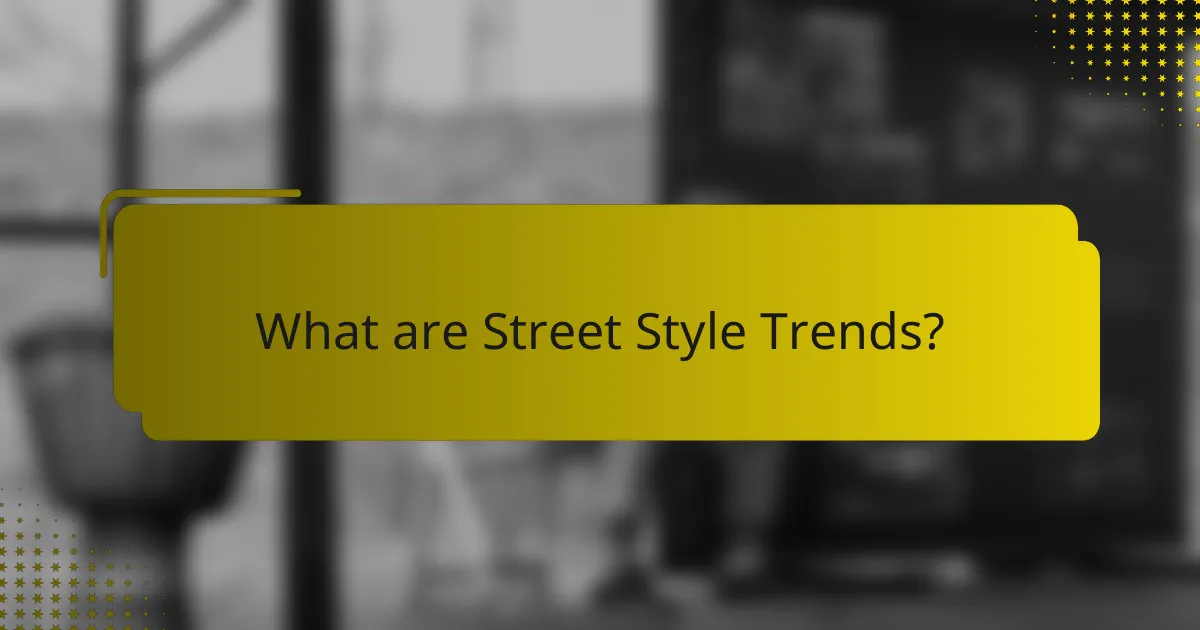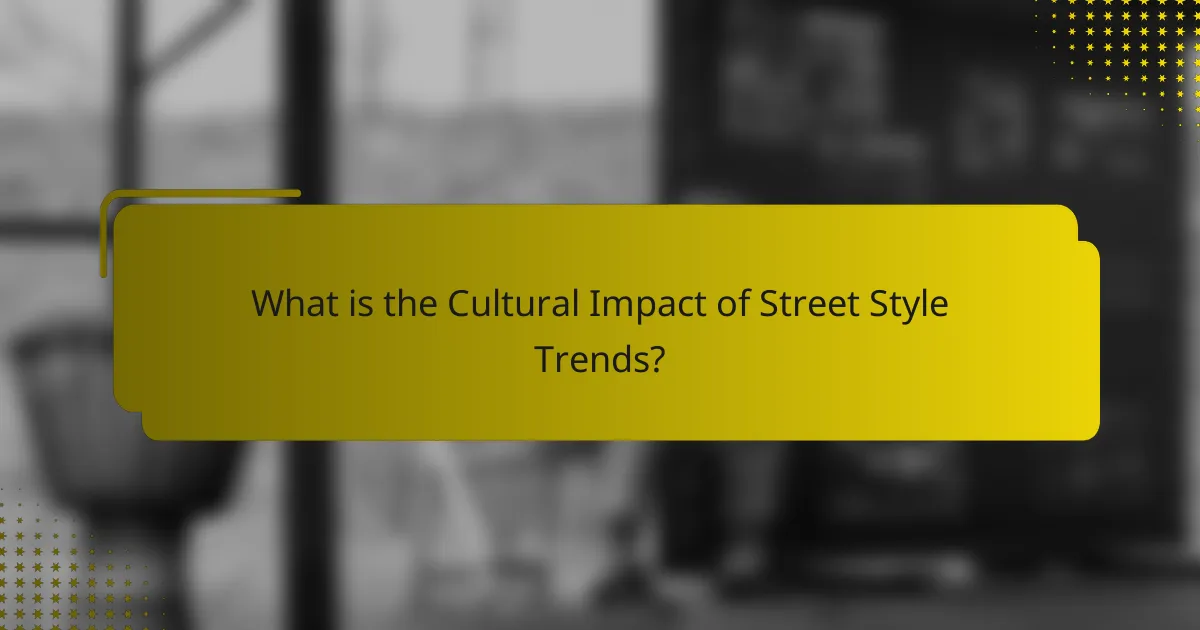
What are Street Style Trends?
Street style trends are fashion movements that emerge from everyday urban settings. They reflect individual expression and cultural influences. These trends often originate from social media, street photographers, and fashion influencers. Street style showcases a mix of high fashion and casual wear. Key elements include unique combinations of clothing, accessories, and footwear. Popular street style trends can vary by location and season. They often challenge traditional fashion norms and promote creativity. Street style has significant cultural impact, influencing mainstream fashion designers and brands.
How did Street Style Trends emerge in fashion?
Street style trends emerged in fashion as a reflection of urban culture and individuality. They gained traction in the 1980s and 1990s, largely influenced by youth subcultures. Punk, hip-hop, and skateboarding styles contributed significantly to this movement. Photographers and street style bloggers began documenting these looks, bringing them to mainstream attention. The rise of social media further accelerated the visibility of street style. Platforms like Instagram allowed for instant sharing and global reach. Major fashion designers started incorporating street style elements into their collections. This fusion of high fashion and everyday wear reshaped industry standards and consumer expectations.
What cultural movements influenced the rise of Street Style Trends?
Street style trends have been significantly influenced by various cultural movements. The punk movement of the 1970s introduced a rebellious aesthetic, characterized by DIY fashion and bold statements. Hip-hop culture in the 1980s popularized casual wear, including oversized clothing and athletic sneakers. The grunge movement of the early 1990s emphasized thrift store finds and a laid-back style, impacting mainstream fashion. Additionally, skate culture contributed to street style with its emphasis on comfort and individuality. Each of these movements reshaped perceptions of fashion, making it more accessible and reflective of personal identity.
How do Street Style Trends reflect societal changes?
Street style trends reflect societal changes by showcasing the evolving attitudes and values of a culture. These trends often emerge in response to social movements, economic shifts, and technological advancements. For instance, the rise of casual wear in street style parallels a growing emphasis on comfort and individual expression.
Historical events, such as the Civil Rights Movement, influenced fashion choices, leading to the adoption of styles that symbolize empowerment and resistance. Additionally, the impact of social media has accelerated the dissemination of street style, allowing diverse voices to shape trends.
According to a study by the Fashion Institute of Technology, street style serves as a barometer for societal sentiments, highlighting how fashion can reflect political and social climates. Thus, street style trends are not just about aesthetics; they are a visual representation of the societal context in which they exist.
What are the key characteristics of Street Style Trends?
Street style trends are characterized by their emphasis on individuality and self-expression. They often blend high fashion with casual wear, creating unique looks. These trends are frequently influenced by youth culture and urban environments. Street style is also known for its use of bold colors and patterns. Accessories play a crucial role in completing outfits. Additionally, street style reflects social movements and cultural shifts. The trends are often documented through social media platforms. Fashion influencers and celebrities frequently shape and popularize these trends.
How do individual expression and creativity manifest in Street Style?
Individual expression and creativity manifest in Street Style through unique clothing choices and personal styling. Street Style reflects individual identities and cultural backgrounds. It often combines high fashion with everyday wear, creating a distinctive look. Influential designers inspire these styles, pushing boundaries of traditional fashion norms. Street Style also incorporates DIY elements, showcasing personal craftsmanship. This approach allows wearers to convey messages or statements about their beliefs. The diversity in Street Style highlights various subcultures and social movements. For example, punk and hip-hop influences are prevalent in many urban environments. Overall, Street Style serves as a canvas for self-expression and creativity.
What role does accessibility play in Street Style Trends?
Accessibility significantly influences street style trends by making fashion more inclusive. It allows a wider range of individuals to participate in style expression. Accessible fashion includes affordable options and diverse sizing, catering to various body types. This inclusivity encourages creativity and individuality in street style. For example, brands like ASOS and H&M have democratized fashion through affordable collections. Research shows that 67% of consumers prefer brands that represent diverse body types. This shift impacts how trends emerge and evolve within street culture. Ultimately, accessibility shapes the landscape of street style by promoting diversity and creativity.

Who are the Influential Designers in Street Style?
Virgil Abloh, Raf Simons, and Hiroshi Fujiwara are influential designers in street style. Virgil Abloh was the founder of Off-White and served as artistic director for Louis Vuitton’s menswear. His designs merged luxury fashion with streetwear aesthetics. Raf Simons is known for his innovative approach and collaborations with brands like Adidas. He has significantly influenced youth culture through his designs. Hiroshi Fujiwara, often referred to as the godfather of streetwear, founded Fragment Design. His work has shaped the intersection of street style and high fashion. These designers have impacted trends and cultural movements in street style. Their contributions are recognized globally within the fashion industry.
What impact have specific designers had on Street Style Trends?
Specific designers have significantly shaped street style trends through innovative designs and cultural influences. Designers like Karl Lagerfeld and Alexander Wang have redefined urban fashion aesthetics. Their collections often blend high fashion with everyday wear. This approach has made luxury more accessible and relatable. Brands such as Off-White, founded by Virgil Abloh, have popularized streetwear in mainstream fashion. Abloh’s unique designs incorporate graphic elements and cultural references. Similarly, designers like Rick Owens challenge conventional silhouettes and promote individuality. This has led to a broader acceptance of diverse styles within street fashion. Overall, these designers have created a dialogue between high fashion and streetwear, influencing consumer choices and trends.
How do these designers incorporate cultural elements into their work?
Designers incorporate cultural elements into their work by using traditional motifs and symbols. They often draw inspiration from local art, textiles, and craftsmanship. This approach reflects the heritage of specific communities. For instance, some designers use indigenous patterns to highlight cultural identity. Others incorporate historical references to tell stories through their designs. Collaborations with local artisans are also common. This practice supports cultural preservation and promotes authenticity. Designers frequently engage with cultural narratives to create meaningful connections with their audience.
What are some signature styles associated with these influential designers?
Influential designers have distinct signature styles that reflect their creativity and vision. For example, Alexander Wang is known for his urban aesthetic and minimalist designs. His collections often feature oversized silhouettes and monochromatic palettes. In contrast, Vivienne Westwood is recognized for her punk-inspired fashion. Her use of tartan patterns and unconventional tailoring sets her apart. Another designer, Karl Lagerfeld, is celebrated for his chic and sophisticated styles. He often combined classic elements with modern twists. These signature styles not only define the designers but also influence street style trends globally.
How do emerging designers contribute to current Street Style Trends?
Emerging designers significantly shape current street style trends by introducing innovative concepts and fresh aesthetics. They often challenge established norms and bring unique perspectives to fashion. Their work is frequently characterized by bold colors, unconventional silhouettes, and diverse cultural influences. Many emerging designers gain visibility through social media platforms, allowing them to reach wider audiences. This accessibility fosters a rapid exchange of ideas and trends. Additionally, collaborations with streetwear brands enhance their impact on mainstream fashion. Events like fashion weeks provide platforms to showcase their designs, influencing consumer tastes. Notably, brands like Off-White and Fear of God emerged from this landscape, demonstrating the potential of new talent. Their contributions reflect a blend of creativity and cultural commentary, resonating with contemporary audiences.
What unique perspectives do new designers bring to Street Style?
New designers bring fresh perspectives to street style through innovative designs and diverse cultural influences. Their work often reflects contemporary societal issues and trends. Many new designers prioritize sustainability, incorporating eco-friendly materials into their collections. They also embrace inclusivity, offering designs that cater to a wider range of body types and identities. This approach challenges traditional fashion norms and promotes individuality. Emerging designers frequently utilize social media to engage with audiences directly. This interaction allows for real-time feedback and trend adaptation. Their unique backgrounds contribute to a rich tapestry of styles, blending various cultural elements. Overall, new designers reshape street style by introducing originality and relevance to modern fashion discourse.
How does social media amplify the influence of emerging designers?
Social media amplifies the influence of emerging designers by providing a vast platform for visibility. Designers can showcase their work to a global audience instantly. Platforms like Instagram and TikTok allow for visual storytelling through images and videos. This immediacy fosters engagement and interaction with potential customers and followers. According to a 2021 survey by Statista, 54% of users reported discovering new brands through social media. Additionally, social media enables collaboration with influencers, which can significantly boost a designer’s reach. The viral nature of content can lead to rapid recognition and sales. Overall, social media serves as a powerful tool for emerging designers to establish their brand and connect with audiences.

What is the Cultural Impact of Street Style Trends?
Street style trends significantly influence contemporary culture. They reflect societal attitudes and values. These trends often emerge from urban youth and marginalized communities. They challenge traditional fashion norms and promote individuality. Street style has been documented in various fashion publications, showcasing its importance. For instance, the rise of hip-hop culture in the 1980s reshaped fashion aesthetics globally. Additionally, street style has become a major influence on high fashion, with designers incorporating these elements into their collections. Social media platforms amplify street style visibility, allowing global reach. Overall, street style trends serve as a barometer for cultural shifts and identity expression.
How do Street Style Trends influence mainstream fashion?
Street style trends significantly influence mainstream fashion by introducing innovative designs and fresh aesthetics. These trends often emerge from urban environments, reflecting the cultural and social dynamics of the streets. Designers and brands observe street style to identify emerging patterns and consumer preferences. This observation leads to the incorporation of casual, eclectic, and diverse elements into high fashion. For instance, the popularity of athleisure in mainstream fashion was heavily influenced by street style, blending comfort with style. Additionally, fashion weeks now often feature street style as a source of inspiration for designers. The rise of social media platforms amplifies street style visibility, allowing trends to spread quickly. This rapid dissemination encourages mainstream brands to adapt and evolve to stay relevant. Overall, street style acts as a catalyst for change, shaping the direction of fashion industries worldwide.
What are the implications of Street Style on fashion retail?
Street style significantly influences fashion retail by driving trends and consumer preferences. Retailers often look to street style for inspiration, as it reflects real-world fashion choices. This influence can lead to quicker turnaround times for new collections. Brands may adapt designs to align with popular street style aesthetics. Additionally, street style encourages a focus on individuality and personal expression in fashion. Retailers may emphasize unique pieces over mass-produced items. This shift can enhance customer engagement and loyalty. The impact of social media amplifies street style’s reach, further shaping retail strategies.
How do Street Style Trends shape consumer behavior?
Street style trends significantly shape consumer behavior by influencing fashion choices and purchasing decisions. These trends often originate from urban environments and are popularized through social media platforms. As consumers observe influencers and peers adopting specific styles, they feel a desire to emulate these looks. This emulation leads to increased demand for particular clothing items and accessories that reflect current street style trends. According to a study by the Fashion Institute of Technology, 70% of consumers reported that social media influences their fashion purchases. Additionally, brands often respond to these trends by launching collections that align with street style, further driving consumer engagement. This cycle of influence creates a dynamic relationship between street style and consumer behavior.
What role does Street Style play in identity and community?
Street style serves as a significant expression of individual identity and community belonging. It reflects personal tastes and cultural backgrounds. Street style allows individuals to showcase their uniqueness. This form of expression fosters a sense of belonging among like-minded individuals. Communities often form around shared fashion aesthetics. Events like fashion weeks highlight the importance of street style in urban culture. Studies show that street style influences mainstream fashion trends. According to a report by the Fashion Institute of Technology, street style shapes consumer behavior and brand perception.
How do Street Style Trends foster a sense of belonging among individuals?
Street style trends foster a sense of belonging among individuals by creating a shared identity. These trends often reflect cultural movements and social values. Individuals adopt styles that resonate with their personal beliefs or community affiliations. This shared aesthetic promotes connection among like-minded people. According to a study by the University of Southern California, fashion can enhance social bonding. Participants reported feeling closer to others who shared similar fashion choices. Street style also acts as a form of self-expression. This encourages individuals to showcase their uniqueness while still feeling part of a collective. Therefore, street style trends serve as a bridge between personal identity and community belonging.
What are the social implications of Street Style on diverse communities?
Street style significantly influences diverse communities by promoting self-expression and cultural identity. It serves as a platform for marginalized voices to showcase their individuality. This form of fashion encourages inclusivity and celebrates diversity across various backgrounds. Street style also fosters community engagement through local fashion scenes and events. Research indicates that street style can enhance social cohesion by bridging cultural gaps. For instance, events like fashion weeks often highlight local designers, boosting community pride. Furthermore, street style can challenge societal norms and stereotypes, encouraging acceptance and understanding. Overall, it plays a vital role in shaping social dynamics within diverse communities.
How can individuals incorporate Street Style Trends into their wardrobe?
Individuals can incorporate street style trends into their wardrobe by mixing casual and edgy pieces. Start with staple items like oversized t-shirts or hoodies. Pair these with tailored trousers or distressed jeans for a balanced look. Accessories play a crucial role; consider adding statement sneakers or a unique cap. Layering is essential; try combining a denim jacket with a graphic tee. Experiment with bold colors and patterns to stand out. Street style often embraces individuality; select pieces that reflect personal taste. According to fashion experts, blending high-end and affordable brands enhances uniqueness. This approach creates a diverse and trendy wardrobe.
What are some best practices for blending personal style with Street Style Trends?
To blend personal style with street style trends, start by identifying your core style elements. Focus on incorporating street style pieces that resonate with your personal aesthetic. Mix high-end fashion with affordable streetwear to create unique outfits. Experiment with layering to add depth and interest. Accessorize thoughtfully to enhance your look without overshadowing your personal style. Stay informed about current street style trends through fashion blogs and social media. Attend local street style events to gain inspiration from others. Finally, remain authentic; confidence in your choices will make the blend seamless.
How can one stay updated on evolving Street Style Trends?
Follow fashion influencers on social media platforms. They often showcase the latest street style trends. Subscribe to fashion magazines and blogs that focus on street style. Websites like Vogue and Hypebeast regularly feature trend reports. Attend fashion weeks and street style events for firsthand insights. Observing street fashion in urban areas also provides real-time updates. Engage with online communities that discuss street style trends. Platforms like Reddit and Instagram have dedicated groups for fashion enthusiasts. Regularly check fashion trend forecasting services for professional insights. These sources provide valuable information on evolving styles and trends.
Street style trends represent fashion movements rooted in urban environments, reflecting individual expression and cultural influences. This article explores the emergence of street style, its key characteristics, and its significant cultural impact on mainstream fashion. It highlights influential designers like Virgil Abloh and Raf Simons, their contributions to street style, and how emerging designers shape contemporary trends. Additionally, the article examines how street style fosters community, promotes inclusivity, and influences consumer behavior, providing insights into the intersection of fashion and societal changes.